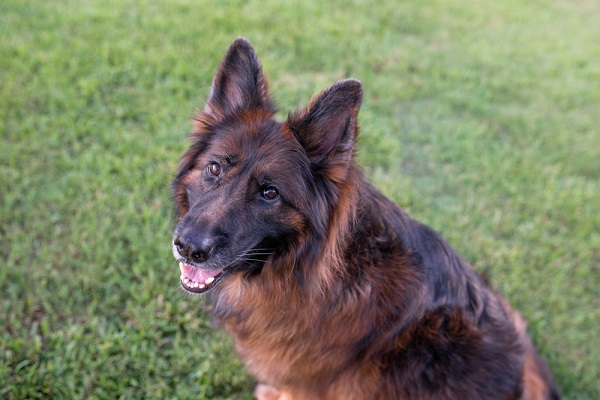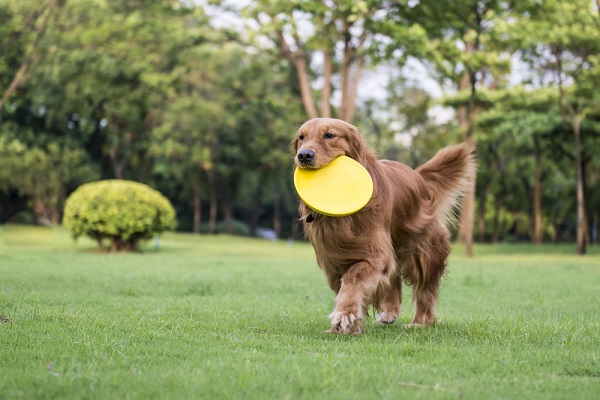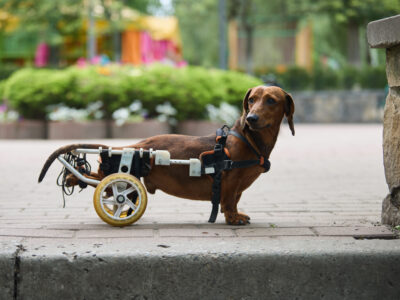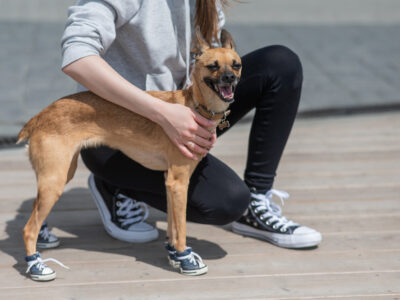If you think you can spot the signs that your dog is in pain, you should know that I missed them, when one of my dogs was sick. Bear was my big, lovable, smart as a whip, 106lb. German shepherd. One evening after dinner, he sat down next to the sofa where I was sitting and stared at me. He wouldn’t take his eyes off of me the whole night. The next morning, I took Bear to see our veterinarian. He was diagnosed with a fast-growing cancer called Hemangiosarcoma.

The warning signs that he was in pain were subtle and hard to detect. There was no whining or crying, pacing or agitation. Instead, my dog asked for help to relieve his pain with his eyes.
It’s up to us to become experts at recognizing the physical symptoms and behavior changes that mean your pup is suffering.
General physical symptoms of pain in dogs
When dogs are in pain, they often exhibit changes in how they carry themselves. These physical signs of pain include:
Behavioral signs of pain in dogs

All dogs are unique and so are their individual behavior changes when they’re experiencing pain. To tell if you dog is showing symptoms of discomfort, watch for changes in your dog’s normal behavior. Most dogs don’t act like “themselves” when in pain.
They may display one or more of the following behavior changes:
Becoming withdrawn and disengaging from family members
Your dog may stop taking part in activities or even hide to protect himself from feeling more pain.
Signs to watch for:
Dog doesn’t want to play
If your dog is usually the first to initiate play, either with you or at the dog park, and he shows no interest in his usual game of fetch, something is bothering him.
Change in eating habits
There are many possible explanations for decreased interest in food. However, (acute or chronic) pain anywhere in your dog’s body can interfere with the appetite or your dog’s ability to reach his food and water.

Get the Essential Guide
The Essential Guide of Products for Handicapped Dogs e-book is a labor of love for me. I wrote it to answer your most pressing questions about where to find the best products for your wheelchair dog. You’ll find products you didn’t know existed and each will improve your dog’s quality of life. Print a copy and keep it by your side.
A new dislike to being touched
If your dog has always loved being touched and develops an intense dislike for being petted or groomed, there is a good chance it’s due to pain. Like humans, dogs want to protect painful joints and limbs. Therefore, they avoid interactions where someone else might touch them and accidentally cause pain.
Change in sleep habits
Disrupted sleep is common in dogs who are in pain. Often lying in one position for an extended period puts pressure on joints. During the day, the stiffness or pain may be less noticeable because movement helps the joints stay mobile. Your dog may wake in the night due to pain and shift positions to get comfortable. If this happens several times during the night, you may find your pup sleeping more during the day.
Pain with mobility

Many dogs experience pain when they walk due to old-age, arthritis, hip and knee problems and diseases in the spine. It can cause severe discomfort when they move, climb stairs or get themselves up from a lying position.
If your dog has pain or trouble with mobility, she may be apprehensive about specific behaviors that once caused no problem.
You could notice some of the following signs:
The takeawy
If your dog isn’t acting like himself, chances are he isn’t feeling well. Make an appointment with your veterinarian as soon as possible. Your vet will be able to determine the cause of the pain and the medical problem.
While waiting for your appointment, keep your pup as calm as possible. Once your vet determines the cause of the pain, your dog will be able to start the road to recovery.
Story contributed by animal writer, Lauren Lee.






To Sharon Seltzer , Nothing Warms My Heart more than a person who truly loves and cares for their dogs cats and other animals. My German Shepherd Buddy became disabled by hip problems last September. I have gone against all those who would have me terminate his life. It takes a lot of time to prepare his meat and vegetable food and for the care that he needs daily. I Choose to do this because he does not deserve to die just because I do not care enough to help him in his time of need. It takes a truly loving animal person to understand this. Two vets even wanted to terminate him at the first visit also. Thank you and please continue with your efforts.
.
Thank you for the kind words. I guess it takes one animal lover to understand another. I hope your dog continues to do well with your care.